Amsterdam is a dynamic city with great appeal. But it’s getting busier in and around the city with the increasing number of pedestrians, cyclists and users of public transport. The Alderman of Amsterdam, Sharon Dijksma, says, “The Commission wants to ensure that the public space in the city now and in the future better fits these developments. This not only means more space for pedestrians, cyclists and public transport, but also sufficient space for relaxation along with green and safe places to play.”
Reduce the presence of the car
The Commission has taken several measures to reduce the presence of the car in the public space in Amsterdam. The recently announced increase in parking fees is one of them. The construction and purchase of a total of four new garages is also part of this plan.
Testing coalition agreement
Existing plans for the construction and purchase of parking garages have been tested against the car-free ambitions of the current coalition. The garages are as follows:
• The construction of the Singelgracht parking garage (800 parking lots).
• The construction of the Vijzelgracht parking garage (around 250 parking lots).
The Commission has checked whether these garages fit in with its plans to make the city car-free. This shows that new measures such as an increase in parking fees and the parking garages mentioned are not so much alternatives to each other, but rather reinforce each other in the ambition to make neighbourhoods car-free.
Opening these garages is a necessary prerequisite to be able to redesign the environment around it. The Commission therefore wants to open these parking garages as quickly as possible.
Large-scale redevelopment of residential areas
Parking garages make it possible to relieve concentrated and large-scale street parking spots in one district at relatively short notice. This makes larger areas completely car-free, which are redesigned into attractive areas, with more space for cyclists, pedestrians and green areas.
Alderman Sharon Dijksma gives an example of this approach citing the transformation of the Frans Hals neighbourhood. “In this neighbourhood, almost all street parking places are being moved during the redevelopment and permit holders and visitors can park at the Albert Cuyp parking garage. This creates a parking-free and almost car-free Frans Hals neighbourhood. The experience at the Albert Cuyp parking garage teaches us that for a successful operation it is necessary to start immediately after opening with the redesign of the area around it, including the removal of the parking places.”
The Albert Cuyp parking garage
Amsterdam is built on foundation piles and consists of many canals. The Albert Cuyp parking garage is the first garage built under an Amsterdam canal. Why under a canal? Due to the lack of space in the surrounding streets the choice was made to build under the canal nearby and also because in various plans the existence of large surfaces of water in this city of canals has been seen as a good place to park cars.
The preparatory work for the construction of this garage was completed by the end of 2015 and the actual construction started in January 2016. The contractor realised this parking garage on behalf of the municipality of Amsterdam, South district.
The architect designed an underground parking facility for 600 cars under the Boerenwetering canal. One hundred and twenty places are intended for visitors from the De Pijp neighbourhood and 480 places are for permit holders in the area.
Design integration at ground level
To increase the liveability of the environment and to make multiple use of space, an underground parking garage has been developed. For the number of underground parking spaces realised, the same number of parking spaces have been removed from the street above ground.
The parking garage is primarily intended for permit holders of the neighbourhood. At ground level, only the car entrance and exit and the two pedestrian entrances of the parking garage are visible. Vents have been included in the pavement as part of the design of the public realm. Besides that, the parking garage reveals nothing at street level, as it is completely contained under an existing canal. The entrance buildings, with an elevator, are very compact and no larger than 25 m2. They are designed in glass to be fully transparent and minimise the presence at ground level while maximising a sense of social security. The fencing along the ramps is also completely transparent. In the public realm, it seems like nothing has changed, except that there are fewer cars and there is much more space on the streets for landscaping and pedestrians.
Maximum attention has been paid to make the existing urban landscape more liveable. All elements of the parking garage at ground level have been kept as small as possible.
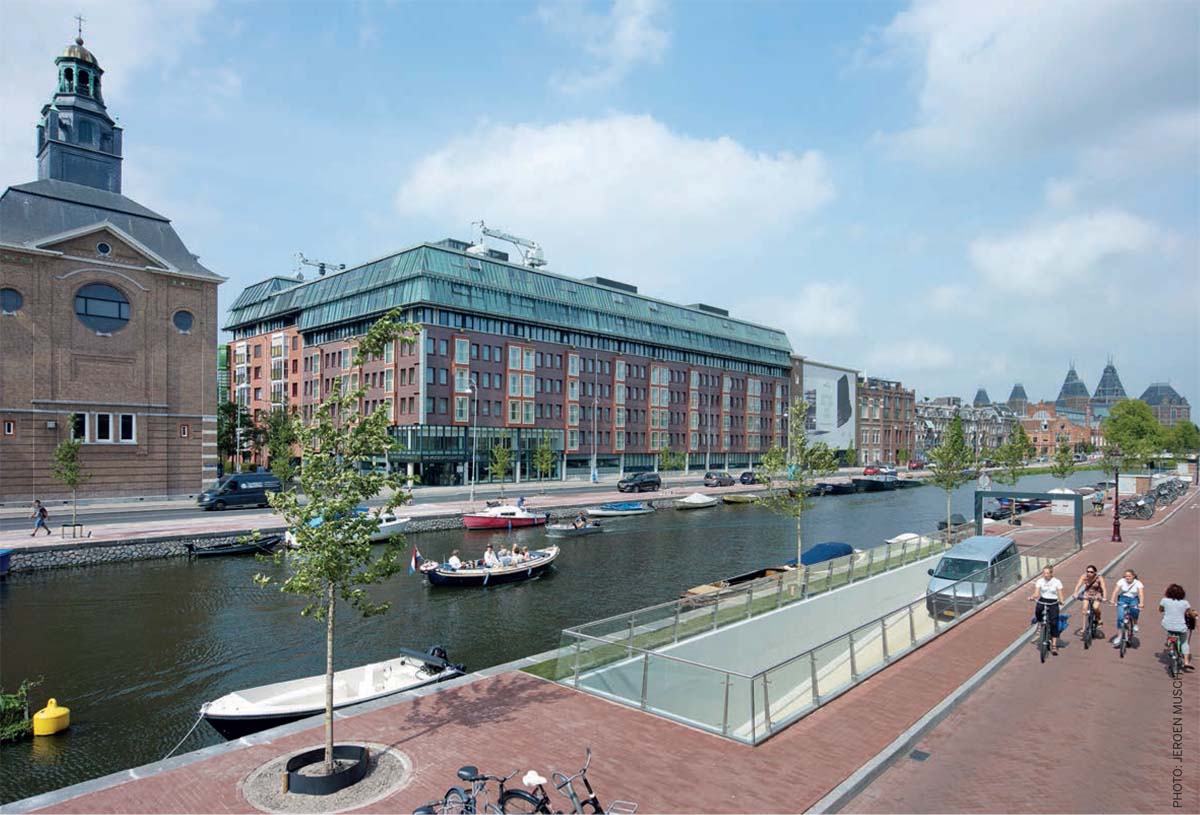
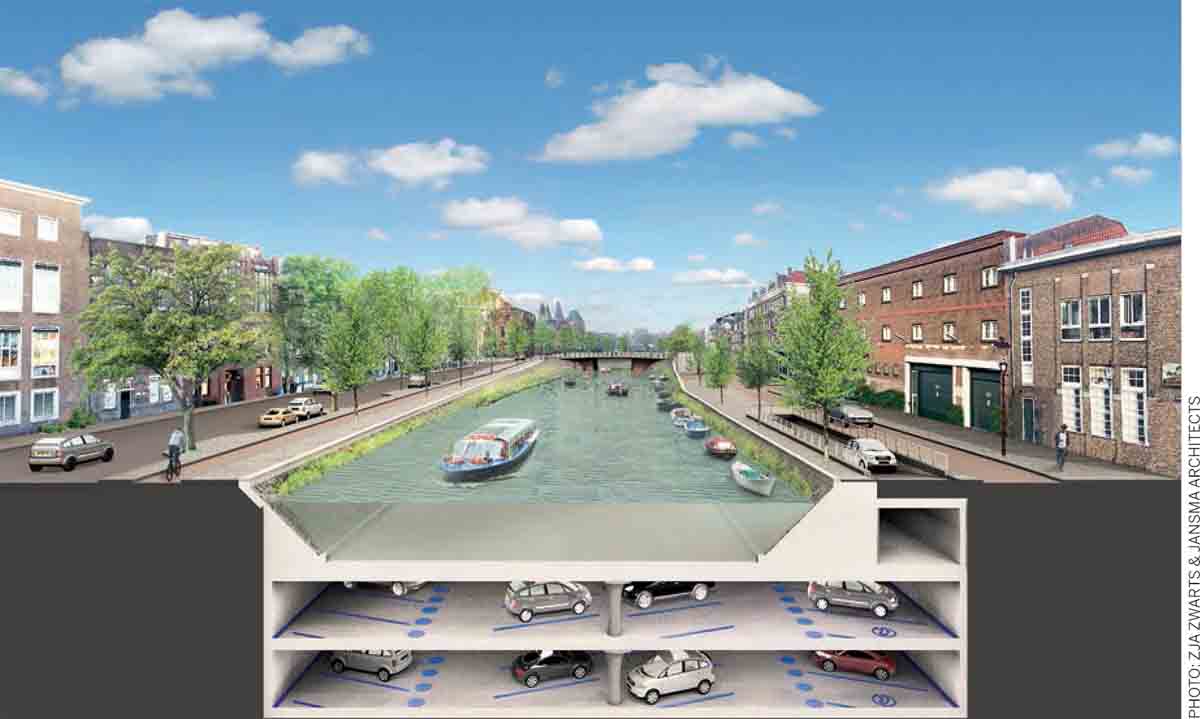
The removal of 600 parking lots from the street creates more space for public greenery, pedestrians, cyclists and play facilities. This will reduce the parking pressure in De Pijp and give a quality boost to the public space in the area.
Every effort has been made to ensure that the addition of the underground parking garage has minimal consequences on its immediate environment. The idea behind the design is to blend the parking garage into the existing urban landscape. All installations are out of sight as far as possible and the ramps are integrated into the side road leading to the canal without any conspicuous elevations. The emergency exits and vents are minimalist objects in the street. The motto is ‘simple and safe’, and the entire structure is visually as unobtrusive as possible, so that the quality of the public space for pedestrians and cyclists remains optimal. The entrances and elevators are therefore modest in size and mostly transparent. The walls of the entrances are made of glass, allowing light and air to enter the parking garage and for easy orientation for visitors/users.
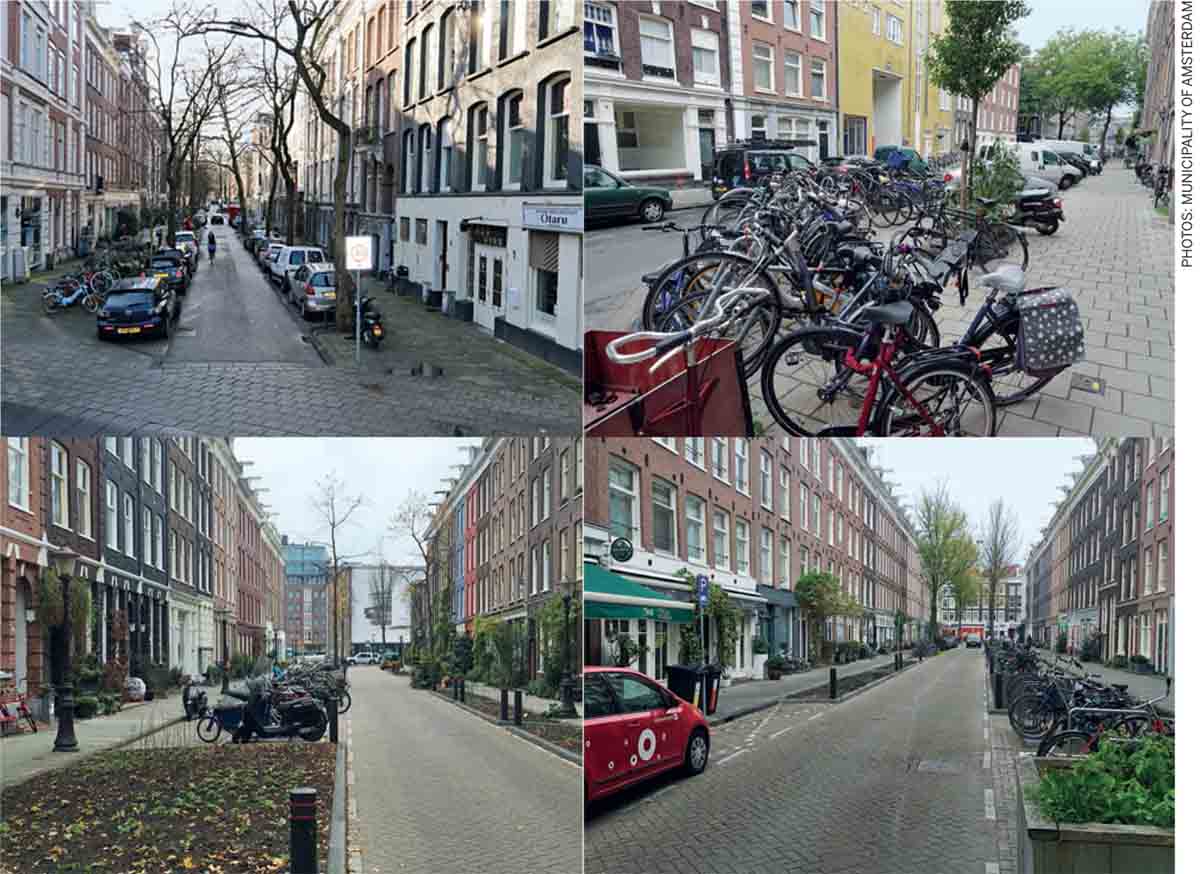
Bottom Left and Right: New and temporary situation(car-free streets)
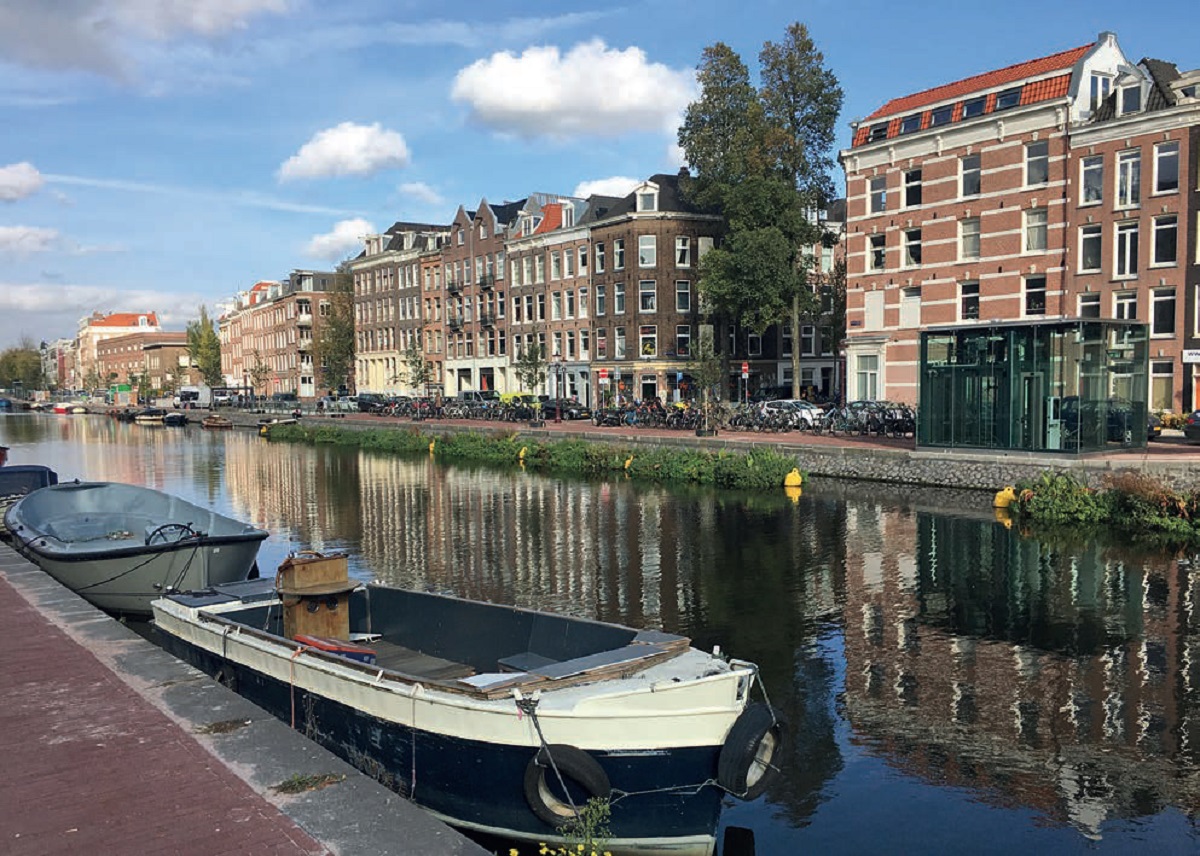
PHOTO: MUNICIPALITY OF AMSTERDAM
The area
The biggest challenge was building an underground parking garage in a densely populated part of the city with hardly any room for storage and narrow and constricted access routes. Above all, there could be no damage done to the foundations of the 19th century houses. The Albert Cuyp parking garage proves it is possible to construct a substantial underground parking facility beneath a canal in marshy soil, in the middle of a densely populated area, enabling a 19th century neighbourhood to benefit from the very latest technology.
Because the parking system records which car is parked in which slot, this qualifies the garage as a smart garage. The real intelligence here, however, lies in the fact that not one square foot of the city has been sacrificed to store 600 cars. Twenty thousand square metres of public space has been given back to De Pijp’s residents and visitors can now enjoy more spacious, greener and quieter streets. The Albert Cuyp parking garage could be a great example for other cities that have limited space above ground with dense building structures.
The design of the parking garage
The location of the entrance and exit of the parking garage are implemented in a logical manner on the existing routes for cars in the urban structure. Along the canal, a one-way traffic structure exists. The entrance and exit are positioned parallel to this structure and directly along the canal and are indicated with a minimally designed portal with markings and height restrictions.
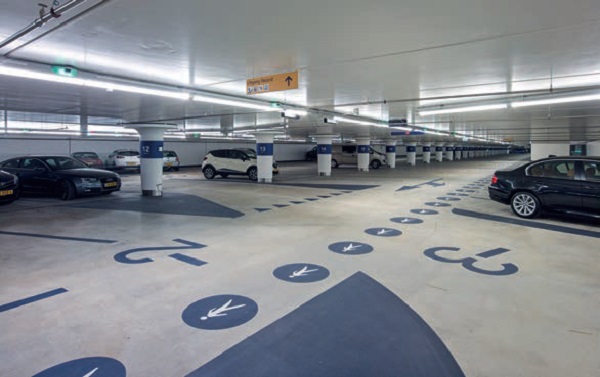
PHOTO: JEROEN MUSCH
For the motorist, the main focus is on the road reference and routing in the garage. For the pedestrian, the focus is on the routing to the entrance and easily finding his parked car. Distinct graphic lines on the floor guide the motorist throughout the garage. These graphic lines provide an overview and clarity in the route to be followed. The pedestrian is accompanied by a graphic dotted pattern towards one of the two entrances. Each column is provided with a unique graphic coding that enhances the retrieval of the car in combination with a ‘find your car’ system using license plates. The graphic design of the lines, dots and coding give the parking garage its own identity. In addition, the unique long linear structure, partly because of the canal, is strengthened.
Due to the size and linear structure of the canal, a cross-section has been created that is the same throughout the entire 260-metre long and 30-metre wide, two-storey parking garage. The principle of this cross-section has remained the same from the preliminary design right up to the construction of the Albert Cuyp parking garage.
The parking system consists of two one-way lanes with parking lots under an angle of 70 degrees on both sides. The occupancy ofspace per parking place is therefore minimal. The linear structure of the existing canal has proved ideal for building a parking garage. The consequences of building in a dense urban environment, under an existing canal with little or no construction site space, can be found in the construction costs.
In addition, 60 bicycle parking lots have been realised in the parking garage. Due to this facility, permit holders living further away from the parking garage can easily use their bike to pick up their car.
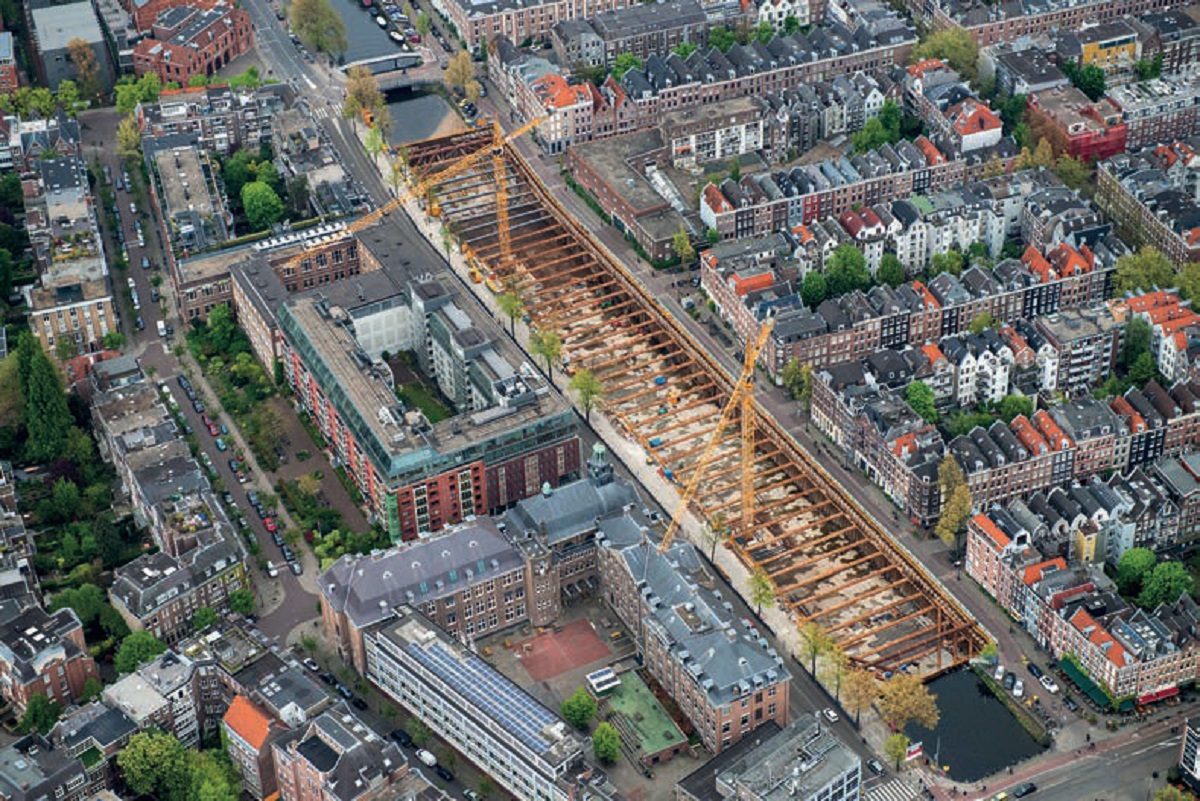
PHOTO: MAX BÖGL NEDERLAND B.V.

PHOTO: MUNICIPALITY OF AMSTERDAM
Future proof
In order to fulfill the requirement to be future-proof, a removable floor has been installed. This allows a functional change in the garage, like shops or living spaces, sometime in the future.
There are also 24 electric car charging stations in the garage and a further 52 units will be added this year to meet the increasing demand.
Construction phase
The construction consisted of several phases. First, the permanent sheet pile walls were placed and the original wall frames removed. In total, 80,000 m3 of ground was removed and transported over water. To ensure the stability of the cofferdam, a temporary steel structure was applied: the stamp frame. The cofferdam has been excavated to a depth of -10.6 metres NAP and more than 1300 GEWI piles were installed to anchor the concrete floor of the garage.
These piles are approximately 14 metres long and were drilled to -23 metres NAP. Then a layer of gravel was applied to control the water load followed by an underwater concrete floor. After sufficient curing of the concrete, all the water was pumped away.
In the construction phase, system floors, walls, lifts and columns were placed. Once the roof was fitted, the stamps could be removed. During the next phase, the technical installations and entrance buildings were positioned and the parking garage given the finishing touches. The public area on ground level was restored and the water pumped back onto the roof of the garage. Finally, the car park was tested extensively and after a refurbishment of the public space in the area, the parking garage Albert Cuyp parking garage has been in use since May 2018.
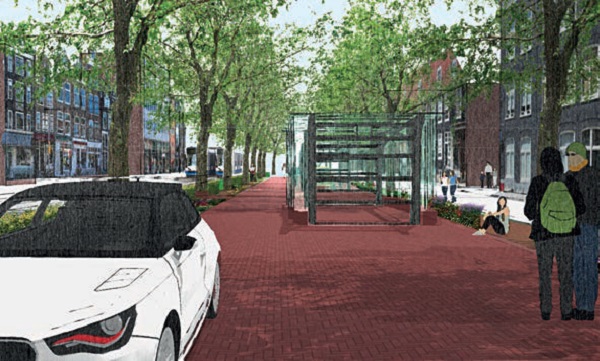
PHOTO: MUNICIPALITY OF AMSTERDAM
Reference project: Vijzelgracht Parking Garage
A similar project that fits within the traffic-free policy and is now in the tender phase is the construction of the Vijzelgracht parking garage.
This parking garage will be fully automatic. In a fully automatic car storage (FACS) you don’t have to park your car yourself; the fully automatic system does that for you. Your car is safe in the FACS, because no humans can enter the garage. As a result, burglary and vandalism do not occur. With motion sensors, the FACS ‘watches’ whether there are people in a car. If motion is detected, the car is not put away.
Where is it situated?
The parking garage is on top of the Vijzelgracht Metro Station of the Noord/Zuidlijn. During the construction of the deep underground station Vijzelgracht, empty space was created above the station. This is now being converted into a parking garage for residents at relatively low cost.


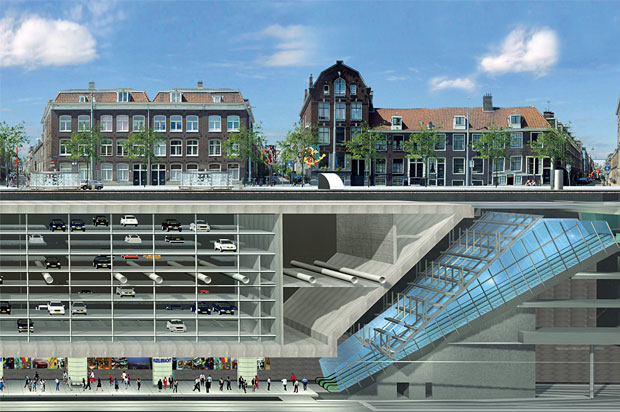

Comments (0)